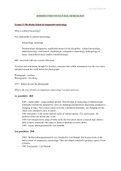Class notes
Lecture notes and summary on "Introduction to Cultural Musicology"
- Course
- Institution
In this document, I have summarized and explained all the concepts that are explained in the lectures, which is all the necessary material to study for the final exam.
[Show more]



